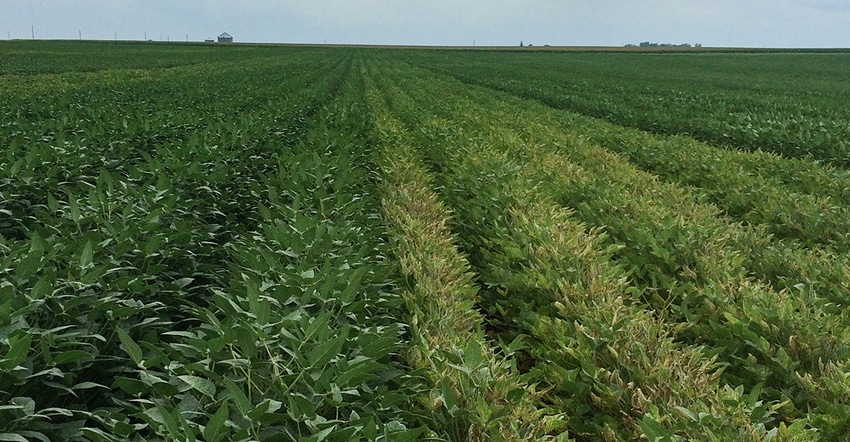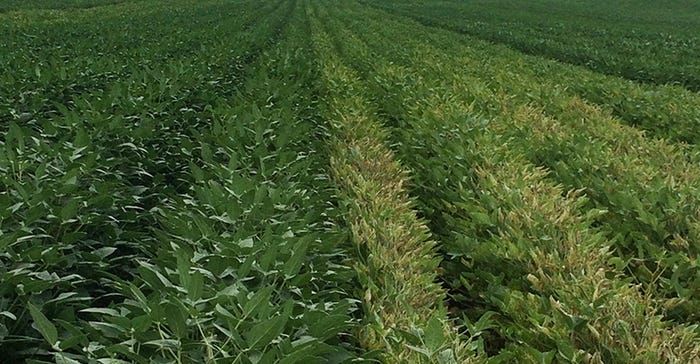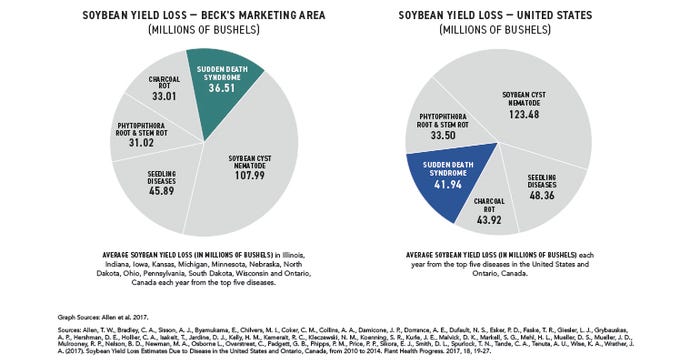March 1, 2019

Sponsored Content
Sudden death syndrome (SDS) was first documented in the United States in Arkansas in 1971, and has continued to spread. In the last 20 years, the disease has become increasingly prevalent in the northern soybean growing regions. Twenty years ago, many northern soybean growing states had no documented cases of SDS, or at least it was not considered a big threat. Now, according to data, (Allen et al. 2017) between 2010 and 2014, SDS was ranked the third highest cause of yield loss in the northern soybean growing states, only behind soybean cyst nematode (SCN) and seedling diseases.
So why has SDS become such an important factor for soybean growers in the northern U.S.? For starters, SDS favors cool, wet conditions, which are often common in the northern U.S. Second, the trend of planting both corn and soybeans early to maximize yield also increases the chances of encountering prolonged cool, wet conditions after planting. Compaction also plays a role in the occurrence of SDS, and poorly drained soils and large equipment can increase the risk of compaction during field operations. In addition to weather, being a relatively new disease in northern areas and the corresponding soybean maturities mean there has been less selection for genetic resistance to SDS in germplasm than in later maturities.
While there is not a perfect answer to combat this disease, there are some things that can help reduce the risk. When choosing varieties, it's important to select products that have high resistance scores to SDS, maintain adequate protection from other agronomic concerns relative to the area, and contain the desired herbicide traits. If possible, plant fields with the most severe history of SDS last in order to reduce the chance of encountering cool, wet soil conditions. With other diseases, crop rotation can decrease risk but unfortunately, the most common crop used in rotation with soybeans, corn, does not reduce SDS incidence.

In addition, there has been debate about the role that SCN plays in SDS infection and severity. Regardless, SCN is the single-most damaging pest in soybeans, so control is a very important consideration. SCN continues to evolve. In some areas, it is overcoming PI88788, the primary source of genetic resistance. Utilizing Peking genetic sources in addition to new seed treatments are important tools to help manage SCN resistance issues.
Recent developments in seed treatment technology provide some level of protection against both SCN and SDS. The seed treatment product ILeVO® can decrease the severity of SDS and has activity on SCN in the root zone. Biological products like Nemasect™ can reduce SCN infection. ILeVO is available as an upgrade in Beck's Escalate SDS and Nemasect™ now comes standard in Beck’s Escalate® yield enhancement system.
Beck’s Practical Farm Research (PFR)® team has conducted several studies over the years testing both ILeVO and Escalate, to determine its effect on SDS and SCN. Click here to view their seed treatment studies.

SDS will continue to be a concern in much of the soybean growing area of the United States, but with continued improvements in genetic resistance and seed treatments that impact both SDS and SCN, it is a disease that can be managed successfully with limited impact on soybean yields in most fields.
Beck’s PFR (https://www.beckshybrids.com/PFR/About-PFR) is the largest source of unbiased, cutting-edge agronomic information in the industry. More than 500 studies were conducted in 2017, comparing over 150 products across multiple locations to learn how different management practices and new technologies perform in field environments. In evaluating agronomic practices and input products, not comparing seed products, Beck’s PFR aims to help farmers maximize their input dollars and increase their bottom line. To view more PFR studies click here. (https://www.beckshybrids.com/pfresearch/)
Practical Farm Research (PFR)® and PFR Proven™ are trademarks of Beck’s Superior Hybrids, Inc. PFR Proven™ was developed in 2016 to identify the products and practices that are likely to be most profitable. If a product has been tested in PFR and found to provide yield gains and averages a positive ROI over a minimum of three years, then that product will earn the status of PFR Proven and should be something to consider trying on your farm. If a practice has been tested in PFR and found to be the most profitable, then it will also receive the status of PFR Proven. Please consult with your local Beck’s representative or trusted advisor for best management practices in your area.
ILeVO® is a registered trademark of BASF. Escalate® and Nemasect™ are trademarks of Beck’s Superior Hybrids.
About the Author(s)
You May Also Like




